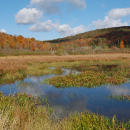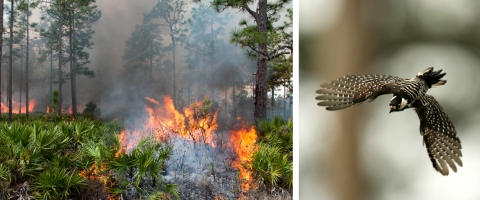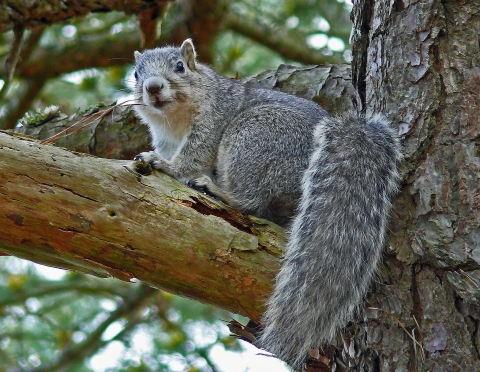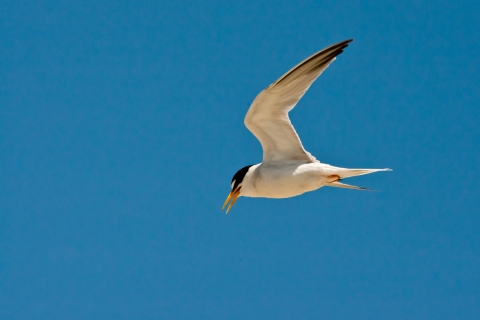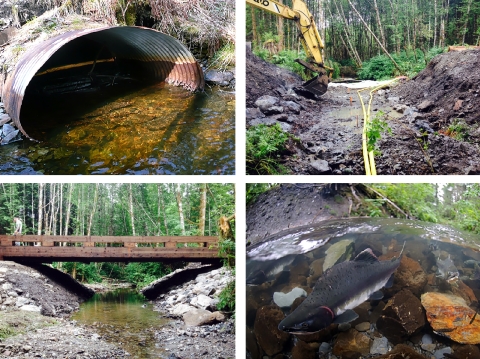What We Do
We are located in 24 priority coastal areas, along the Atlantic and Pacific Oceans, Gulf of America, Great Lakes, and in the Caribbean. Working with partners, locally-based staff provide technical assistance for habitat conservation design and planning, and financial assistance for habitat restoration and protection projects.
Field staff work directly with partners to implement conservation projects that support the following goals:
- Creating coastal ecosystems that are resilient and adaptive to climate change climate change
Climate change includes both global warming driven by human-induced emissions of greenhouse gases and the resulting large-scale shifts in weather patterns. Though there have been previous periods of climatic change, since the mid-20th century humans have had an unprecedented impact on Earth's climate system and caused change on a global scale.
Learn more about climate change impacts. - Using science-based conservation design at a landscape scale that supports habitat connectivity and ecological integrity.
- Benefitting the conservation and recovery of federal trust species and other priority species.
- Building conservation partnerships that leverage resources and promote community stewardship of fish and wildlife resources.
Our Services
Our Projects and Research
Prescribed Fires
The Babcock Ranch Preserve (Preserve) covers 73,000 acres in south-central Florida, and includes several unique habitat types containing dozens of state and federally protected plants and wildlife. Invasive species can displace native plants and animals, which can impair an entire ecosystem.
The Coastal Program partnered with Babcock Ranch, Inc., and the Florida Fish and Wildlife Conservation Commission to develop and implement an invasive species invasive species
An invasive species is any plant or animal that has spread or been introduced into a new area where they are, or could, cause harm to the environment, economy, or human, animal, or plant health. Their unwelcome presence can destroy ecosystems and cost millions of dollars.
Learn more about invasive species management and monitoring plan to restore 884 acres of habitat on the Preserve. Prescribed fire and herbicide were used to remove invasive plants, including Brazilian pepper, cogon grass and water hyacinth. After the treatment, monitoring for amphibians, Florida scrub-jay, and red-cockaded woodpecker will be conducted to evaluate the success of the project.
Habitat Protection
The Service is proposing to remove the Delmarva fox squirrel, one of the first federally listed endangered species, from the endangered species list. Fox squirrel habitat had declined to 10% of its historic range due to habitat loss from timber harvests and agricultural production. Conservation efforts, such as squirrel reintroductions and habitat restoration, have returned fox squirrels to 28% of their historic range – which is a level biologists believe can sustain the species.
Habitat protection projects, like the Chicamacomico River conservation easements in Maryland, also played an important role in the fox squirrel recovery. The Coastal Program worked with the Maryland Department of Natural Resources and private landowners to protect over 442 acres of salt marsh salt marsh
Salt marshes are found in tidal areas near the coast, where freshwater mixes with saltwater.
Learn more about salt marsh , forested wetlands, forests, and farmland, located near the Blackwater National Wildlife Refuge. Coastal Program staff worked with partners to identify critical fox squirrel habitat, secure grant funds, and prepare easement documents.
Fish Passage Restoration
The Coastal Program and the Nature Conservancy have been working together to conserve ecologically important habitats in the rainforest archipelago of Southeast Alaska, including the Harris River watershed on Prince of Wales Island. The watershed is important for salmon and other sport fish, and has been degraded over many years due to periodic logging activities and undersized culvert stream crossings that cause stream channel degradation and create fish passage fish passage
Fish passage is the ability of fish or other aquatic species to move freely throughout their life to find food, reproduce, and complete their natural migration cycles. Millions of barriers to fish passage across the country are fragmenting habitat and leading to species declines. The U.S. Fish and Wildlife Service's National Fish Passage Program is working to reconnect watersheds to benefit both wildlife and people.
Learn more about fish passage barriers.
The Coastal Program has been providing technical and financial assistance to replace culverts with bridges to restore natural stream functions, and habitat connectivity. These restoration projects benefit pink, chum and coho salmon, and cutthroat trout and Dolly Varden char. These bridges also reduce infrastructure maintenance costs and improve public safety.
Urban Restoration
Urban conservation is increasingly important to migrating birds and waterfowl because of habitat loss and fragmentation. In Long Beach, California, the Coastal Program worked with numerous government agencies, conservation organizations, and corporate partners to restore the 18-acre Colorado Lagoon. The lagoon is part of a 500-acre remnant of the Los Cerritos Wetlands, which once included over 2,400 acres of coastal wetlands.
This project also provides an excellent opportunity to educate the public about environmental stewardship. Since 2008, our staff also helped facilitate over 300 community events, including invasive species removals and native vegetation plantings, which were critical to building support for a large-scale restoration project.
Despite its urban location, Colorado Lagoon hosts native salt marsh that provides habitat for over 75 species of marine birds, including the state and federally endangered California least tern. It is also one of the first estuaries along the southern route of the Pacific Flyway where migrating birds can rest and feed after traveling through Los Angeles.
Dam Removal
In collaboration with Connecticut's Division of Inland Fisheries and The Nature Conservancy, the Coastal Program restored fish passage on the Anguilla Brook, which eventually flows into Long Island Sound, New York. The project involved the modification of one dam to allow for fish passage, and the removal of another dam. The project reopened 13 river miles and 51 acres of wetlands, which restored the river herring’s entire historic spawning range.
River herring is an anadromous fish that spends most of its life at sea, but returns to freshwater streams to breed. Historically, river herring were an important fishery, well established even before the American Revolution. River herring are also ecologically important as a food source for ospreys, herons, Bald eagles, River otters, Striped bass, Tuna, and whales. Since the 1960’s, herring populations have continued to significantly decline due to overharvesting and loss of spawning habitat. The potential for the river herring be lost forever underscores the importance of habitat restoration and commercial fisheries management.


